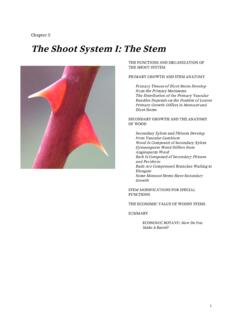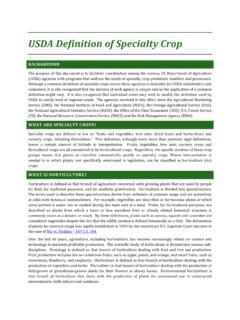Transcription of Chapter 4 The Organization Of The Plant Body
1 1 Chapter 4 The Organization Of The Plant Body Plant CELLS AND TISSUES There Are Three Types of Simple Tissues: Parenchyma, Collenchyma, and Sclerenchyma Complex Tissues Make Up the Plant 's Vascular System and Outer Covering Secretory Tissues Produce and Secrete Materials MERISTEMS: WHERE CELLS DIVIDE What Is a Meristem? What Are the Categories of Meristems, and How Do They Differ? SUMMARY PLANTS, PEOPLE, AND THE ENVIRONMENT: Plant Anatomists as Detectives? ECONOMIC BOTANY: Music from Plants 2 KEY CONCEPTS 1. T h e plan t body is composed of individual cells t h at a r e o r g a nized into a g g r e g at es of cells called tissues. The cells of each tissue function as a unit. 2. Simple tissues a r e composed of cells t h a t a r e all of t h e s ame t ype.
2 Complex tissues are composed of more than one cell type. Tissues may function as structural supports, protective coverings, or transporters of water and nutrients. 3. Me ristems a r e t h e sit es of cell division a nd differ e n tiation in t h e pla nt body. A hie rarchy of meristems exist in the Plant body, each with a specific role in Plant development. Organization OF THE Plant BODY The next time you are outside, notice the amazing variation in the forms that plants take. Despite the big differences between them, they all have evolved a basically common mechanism for development and a similar internal body plan. This Chapter and the next few chapters examine the internal structure of vascular plants. These plants include ferns, cone-bearing plants (gymnosperms) like pine trees, and flowering plants (angiosperms) like rose bushes and grasses.
3 The Plant body of most vascular plants consists of an aboveground part, the shoot system, which includes stems, leaves, buds, flowers, and fruits, and a belowground part, the root system, composed of main roots and branches (Fig. ). This Plant body is constructed from millions of tiny cells, each having a characteristic shape and function. This Chapter will examine several different cell types, tissues (aggregates of cells), and their origins from unique parts of the Plant body called meristems. Plant CELLS AND TISSUES Around each Plant cell is a cell wall. Living cells filled with water exert force (turgor pressure) against their walls, making each cell a rigid box. Plant cells are glued to each other by a material called pectin, and collectively they form a very strong yet flexible Plant body.
4 Plants consist of many different types of cells th at are organized into aggregates called tissues. Tissues are derived from specialized groups of dividing cells called meristems. Meristems are the source of cells and tissues and therefore they are not strictly speaking tissues themselves. The organs of the Plant , leaves, stems, roots, and flower parts are composed of tissues arranged in different patterns. Tissues in the Plant body are made up of both living and dead cells. The dead cells, often with thick, strong cell walls, are retained as strengthening cells. Knock on your wood table right now, and you'll see firsthand how strong and hard these dead cells are. The main tissues of plants may be grouped into three systems (Fig.)
5 The ground tissue system is the most extensive, at least in leaves (mesophyll) and young green stems (pith and cortex). The vascular tissue system contains two types of conducting tissues that distribute water and solutes (xylem) and sugars (phloem) through the Plant body. The dermal tissue system (epidermis and periderm) covers and protects the Plant surface. 3 Figure The Plant body, shown here as a tomato Plant , consists of the shoot system (leaves, buds, stems, flowers and fruits) and the root system (roots). Each organ is made up of cells organized into tissue systems: dermal, vascular and ground. One way the vegetative organs (leaves, stems and roots) differ from each other is in the distribution of the tissues.
6 Some of the tissues are composed mostly of a single cell type; these are called simple tissues. Tissues made from aggregates of different cell types are called complex tissues. Tissues, simple or complex, act together as a unit to accomplish a collective function and are derived from meristems. Table lists the Plant tissues described in this Chapter and their cell types. shoot tip (terminal bud) axillary bud young leaf flower petiole leaflet leaf seeds (inside fruit) EPIDERMIS hypocotyl withered cotyledon root hairs lateral root primary root SHOOT SYSTEM ROOT SYSTEM GROUND TISSUES VASCULAR TISSUES node internode node node internode root tip root cap 4 There Are Three Types of Simple Tissues: Parenchyma, Collenchyma, and Sclerenchyma The simple tissues are made of cells that are the workhorse cells of the Plant body.
7 They do the photosynthesis, load things in and out of the vascular system, hold up the weight of the Plant , store things, and generally conduct the important business and housekeeping chores needed to keep the Plant body healthy and functioning. PARENCHYMA Parenchyma cells are usually somewhat spherical or elongated, but t hey m ay hav e diverse shapes (Fig. ). T h e y usually h a v e a t hin prima r y cell wall, but they may have a secondary wall, which is sometimes lignified (Fig. ). Lignin is a polymer that is embedded between cell wall cellulose molecules. It renders the wall impermeable to water, so that water movement occurs only through openings in the cell wall called pits. Lignin is also quite hard and strong, making lignified cells rigid and supportive even when the cells are dead.
8 Living parenchyma cells found in all Plant organs perform the basic metabolic functions of cells: respiration, photosynthesis, storage, and secretion. Parenchyma cells usually live for one to two years but have been known to live hundreds of years in some pla nts, such as cactus. Crystals of many different shapes and sizes, usually made of calcium oxalate, are commonly found inside the vacuoles of parenchyma cells (Fig. ). They may be involved in regulating the pH of cells by crystallizing oxalic acid (which is a way of taking it out of solution). Parenchyma cells may occur as aggregates forming parenchyma tissue; the cortex and pith of stems and roots and the mesophyll of leaves are composed of parenchyma tissue (Fig. ). The cortex is the region between the Plant 's epidermal and vascular tissues in most stems and roots.
9 The pith is usually composed of storage parenchyma cells and lies at the center of many stems, inside the cylinder of vascular tissues. In some stems, such as corn (Fig. ), the vascular tissue is dispersed in bundles. In this case the parenchyma tissue making up the bulk of t he s t em is simply called ground tissue, and t he t erms cort ex and pith are no t used. The mesophyll makes up the bulk of most leaves and is the site of most photosynthesis and water storage in leaves (Fig. ). Sometimes the air spaces are very large, especially in the stems and leaves of plants that grow in wet places. 5 Parenchyma cells are unique in that mature ones can be developmentally reprogrammed to form into different cell types, especially after wounding.
10 For instance, within several hours after a Coleus stem is wounded, the parenchyma cells immediately around the wound start to divide. After two days or so some of these cells differentiate into xylem cells, which can transport water around the wound (Fig. ). Transfer cells are modified parenchyma cells that have many cell wall ingrowths (Fig. ). T his e n ables t h es e cells to improv e t h e t r a nsport of wa t e r a nd min e r als ov e r s hor t distances between themselves and attached cells. Transfer cells are found at the ends of files of vascular cells, where they help load and unload sugars and other substances. COLLENCHYMA Collenchyma is a tissue specialized to support young stems and leaf petioles (this is the leaf part that holds the leaf blade to the stem).


